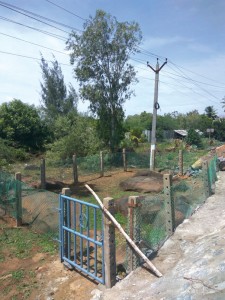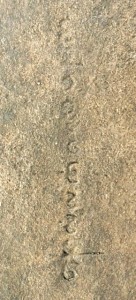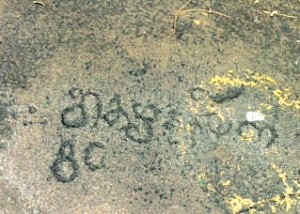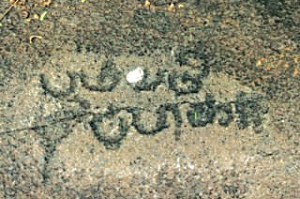Registered with the Registrar of Newspapers for India under R.N.I 53640/91
Vol. XXVI No. 11, September 16-31, 2016
Our Readers write
More on Tamizh Vaanan

The new projected Punjeri rock with its inscriptions.
Dr. G. Sundaram’s letter on Tamizh Vaanan (MM, August 1st) kindled my own memories of Kalkandu. We (my brother and I) were regular readers of the magazine in the late forties/early fifties. The most anticipated feature in the magazine was the mystery thriller serial written by Tamizh Vaanan (TV) himself, called Marma manidhan (Mystery man). The story was about a mysterious criminal who used to move around totally covered in a shroud committing various offences including murder. The hero was a private detective by name Shankarlal (rather an odd name for hero of a Tamil story those days!) who assisted a not too bright police inspector called Wahab in the investigations ( Shades of Sherlock Holmes and Dr Watson!). In one of the episodes Shankarlal was shot by Marma manidhan (again like Sherlock Holmes Vs. Dr. Moriarty) but due to popular outcry, Shankarlal had to be revived and the series went on. I still remember the last sentence of the final episode in which Shankralal reveals the identity of Marma manidhan to Inspector Wahab “Aaam, Sreedharan dhan Marma manidhan” enraar Shankarlal. (In fact Sreedharan is Marma manidhan, said Shankarlal)
I also recall that TV used to humourously refer to himself as Tamizh Vannaan – ‘The washerman of Tamil’!
K. Balakesari
3/1, Kesari Kuteeram,
22, Westcott Road, Royapettah,
Chennai 600 014
DPI Campus then
As I read the report about DPI’s Campus, I remembered my first visit there in 1949 as a student of Teachers’ College. There used to be a lovely garden in the front and it has disappeared long back to make way for parking of vehicles. There were three buildings in the huge campus besides the MLS Library Building. Behind the main building was the annex which the correspondent refers as housing UNICEF. The quarters for the DPI was at the far end on the banks of the canal.
When N.D. Sundaravadivelu became DPI, he preferred to live in his own house. S.V. Chittibapu, the then Joint Director occupied the mansion. When the State Council of Educational Research and Training was established, DPI’s quarters became its office, in spite of its unsuitability. The first new construction in the Campus was the office of the Examination wing of the Department later to become a separate Directorate in 1968. At the far end on the banks of the canal were some old buildings which were rumoured as the barracks of Lord Clive. Now a good number of buildings have come besides a Hindu Temple, a small church and prayer hall. The old world charm has been completely lost. Similar seems to be the fate of DMS Campus.
S.S. Rajagopalan
30, Kamarajar Stret,
Chennai 600 093
Correct location
I would like to point out a small correction in the stretch mentioned about Cathedral Road. Cathedral road stretched from Mount Road (Anna flyover) to Music Academy. There was a round tana at this junction. From that point eastwards upto the erstwhile IG Office (now DGP Office) the road was called Edward Elliots Road (present Dr. Radhakrishnan Salai) and St. Ebbas school was situated in this stretch and not on Cathedral Road.
Arumugam PK
pkarumugham@live.com
Saving the Punjeri inscriptions



Some of the inscriptions
The Punjeri inscriptions chiselled on hard (granite) rock in the village of Punjeri (the rocks are locally referred to as Nondi Veerapan Kudiraithotti) near the world heritage monument township of Mamallapuram, are in the archaic Tamil and Grantha (Pallava) script dating to the 7th Century C.E. This find, excavated in the 1930’s, is the oldest relatable inscriptional evidence of those whom scholars now can refer as the artisans who probably worked on the famed monument.
An extract from the book Inscriptions of the Pallavas by T.V. Mahalingam, brought out by the Indian Council of Historical Research, records seven personal names, viz. Kevada Peruntaccan (the chief sculptor), Gunamallah, Payyamilippan, Catamukkiyan, Kaliyani, Abhajar of Tiruvorriyur and Kollan Semagan. These are the names of some of the artisans who, in the reign of the Pallava king Paramesvaravarman I, probably worked at the site and form a vital link in deciphering the life and times of the people in the region.
The widening of the East Coast Road, State Highway No.49, caused much concern to heritage lovers, as the inscribed rocks were only a little away from the highway, and any expansion would have certainly jeopardised them and other heritage protection work done in the area. This danger was first brought to the notice of Friends of Heritage Sites (FoHS), by K.T.Gandhirajan, a historian. FOHS brought the danger to the notice of Government officials and sought to save the inscriptions.
At a sculpture exhibition held in March 2015, to revive the Ajanta tradition that later evolved into the Pallava art form, and was aptly called ‘Vichitrachitta’, a title given to the Pallava king Mahendravarman I, FoHS highlighted the neglected condition of this horse-shoe-shaped rock, covered with foliage and garbage, and the road widening activities on the ECR. FOHS made representations to the Archaeological Survey of India, at both State as well as Central level, and to the Highways Department, bringing to their notice the impending damage to this vital heritage relic in the vicinity of the World Heritage Centre.
A few weeks ago, the inscriptions were saved. The Highway has been moved so as not to disturb the site and the ASI has fenced the area. It was a pleasant surprise to see the proactive and forthcoming attitude of the departments involved after a case of the left hand not knowing what the right hand was doing. We only hope there are better coordinating efforts in future by different governmental bodies, especially around heritage sites.
FoHS is a society working towards creating a social space for heritage enthusiasts, consolidating conservation of ecology in relation to heritage monuments and natural heritage sites by coordinating with government bodies, and working with local communities to enhance their livelihood. It generates awareness programmes to protect sites under threat of vandalism, and engages persons from all walks of life and the media to create a better ambience in and around heritage sites.
This NGO had its genesis in early 2014, when a few friends on a field trip in rural Tamil Nadu observed that there was very little that the local public knew when it came to understanding the value of a heritage monument or a site. There seemed to be scant regard shown to these monuments by the locals and a certain disconnect between those living near a heritage monument site and understanding of heritage per se. This disconnect and ignorance had, over time resulted in little care or value for the heritage around them and was quite often directly responsible for encroachments, vandalism and misuse of a heritage space. This divide, which shocked the group, was uppermost in their mind in wanting to start an organisation that would bridge the gap and bring about a better awareness and understanding of heritage among the locals who are the stakeholders in the upkeep of these monuments.
Acting on this ‘FRIENDS of HERITAGE SITES’ (FoHS), a society, was found in August 2014 by eight founder members.
Chithra Gopinath

